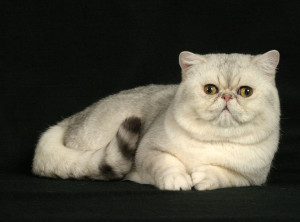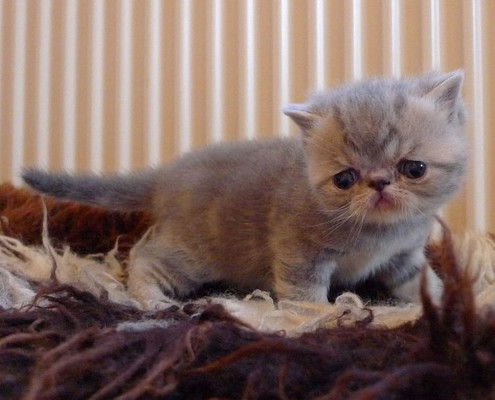Exotic Shorthair

Meoww!!
An exciting, fun cat, the Exotic does not mind changes in routine and is generally friendly with anyone and everyone.
In 5 Words
- Placid
- Active
- Friendly
- Loving
- Intelligent
Snapshot
WEIGHT RANGE:
Male: large: >12 lbs.
Female: medium: 8-12 lbs.
EYE COLOR:
Blue, Copper, Hazel, Odd-eyed
EXPECTATIONS:
Longevity Range: 8-10 yrs.
Social/Attention Needs: Moderate
Tendency to Shed: High
COAT:
Length: Medium, Long
Characteristics: Straight
Colors: White, Red, Cream, Black, Blue, Chocolate, Lilac, Silver, Golden Cameo, Tortoiseshell, Bluecream, Brown, Lilac Cream, Calico
Pattern: Solid color, Tortoiseshell, Bicolor, Tricolor/Calico, Tabby, Smoke, Shaded, Points
Less Allergenic: No
Overall Grooming Needs: High
CLUB RECOGNITION:
Cat Association Recognition:
CFA, ACFA , FIFe, TICA
Prevalence: Common

Characteristics
Learn About the Exotic Shorthair
The Exotic Shorthair grew from a different original desire. American Shorthair breeders bred to Persians to obtain their lovely silver color and green eyes. The kittens were pretty to look at but did not meet the true American Shorthair type. Jane Martinke noticed the effect the outcrosses had on the American type and coat as well as the attractiveness of the kittens.
In the late 1950s American Shorthair breeders, motivated by the popularity of the Persian, secretly began to mix Persians into their American Shorthair bloodlines to improve body type and to introduce the beautiful and favored silver Persian color into the American.The early pioneers of this breed made a concerted effort to standardize the fluffy, flat-faced, short-haired cats into a distinct, readily-reproducible breed.A little livelier and more playful than the Persian, the Exotic Shorthair shares many of the Persian’s gentler personality features.
The Exotic maintains all its Persian characteristics with the exception of a short dense fur coat. They are medium sized with large and solid bones. They have the flat faces of the Persian but a short plush teddy-bear look, and the usual small squeaky Persian voices. They have the flat faces of the Persian but a short plush teddy-bear look, and the usual small squeaky Persian voices. The ideal Exotic Shorthair should be well proportioned, medium to large cat giving the impression of elegant robust power. The head is massive with small, rounded ears, large, round, wide-set eyes and a short nose presenting a sweet expression.
The Exotic Shorthair tends to show more affection than many other short-haired domestic breeds, without being annoyingly demanding. This is an easy-going, quiet cat, whose voice is rarely heard. The Exotic Shorthair is sweet, calm and unfailingly loyal.Exhibiting traits of its Persian cat lineage, Exotics are sweet, gentle and most comfortable around quiet and familiar surroundings. Exotic will enjoy playing with a fishing-pole toy or chasing a ball or wadded-up piece of paper. Puzzle toys that require him to think and move to release treats or kibble are a great way to keep him occupied when you aren’t there to provide a lap. You can even use a clicker to teach him tricks such as “Sit” or “Wave.”. They want to be involved in their favorite humans’ lives and will quietly follow them from room to room just to see what they are doing.
Exotic Shorthairs are sinus problems, tear duct problems, and eye problems such as Keratosis Sequestrium (which is existant in both Persian-types and Siamese, and is not genetic-based, but rather a consequence of having an extreme amount of exposed eye surface).
- Epiphora (Excessive Tearing): Relatives of the Persian and Himalayans are generally more prone to chronic eye irritations and infections that produce tearing and staining of the hair below the eyes.
- Feline polycystic kidney disease (PKD). Exotic shorthairs as is the case of Persians and other Persian derived cats have a high chance of inheriting PKD, a disease that can lead to kidney failure. Several studies using ultrasound scan screening have shown that the prevalence of PKD in exotics is between 40 and 50% in developed nations.
The Exotic sheds seasonally and will need additional grooming and bathing during that time to remove dead hair. After a bath, dry him thoroughly with a professional stand dryer or a hand-held blow dryer, but keep the temperature setting on low to prevent burns.Weekly combing is recommended simply for the purpose of smoothing out the coat, and for keeping hairballs to a minimum.To prevent ugly staining, wash his face daily, particularly beneath the eyes. Trim the nails as needed.






